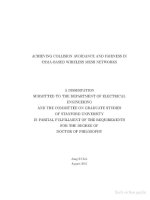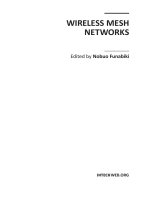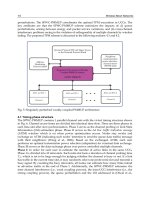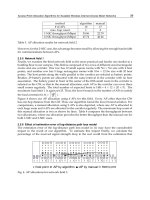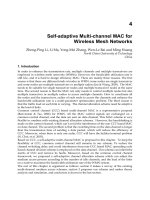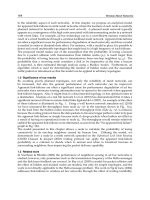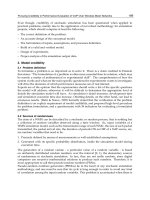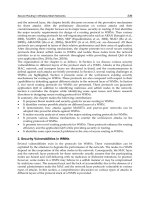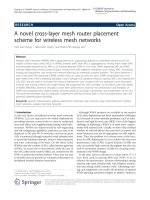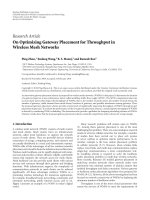Wireless networks - Lecture 31: Wireless mesh networks
Bạn đang xem bản rút gọn của tài liệu. Xem và tải ngay bản đầy đủ của tài liệu tại đây (674.52 KB, 31 trang )
Wireless Networks
Lecture 31
Wireless Mesh Networks
Dr. Ghalib A. Shah
1
Outlines
Introduction to WMN
Characteristics
WMN vs MANET
Architecture
Applications
Critical factors influencing performance
► Radio techniques, scalability, QoS, security, Ease of
Use, Mesh connectivity
2
Last Lecture
Limitations of QoS in IEEE 802.11
Overview of 802.11e
Traffic Categories
EDCF
HCF
Mobile IP
►
►
►
►
►
Care-of-address,
MIP Protocol (Discovery, Registration, Tunneling)
Routing
Inefficiencies
MIPv6
3
Introduction
Wireless mesh networks (WMNs) comprised of mesh
routers and clients
Mesh clients not only work as host but also perform
routing for multi-hop destinations
Mesh routers support bridge/gateway functionalities
enabling integration of WMNs with existing wireless
networks such as cellular, WSN, WiMAX etc
WMN is dynamically self-organized and self-configured
4
Conventional nodes e.g. PC, PDA, PocketPC, phones ,
equipped with wireless NIC can connect directly to
mesh routers.
Without Wireless NIC, Ethernet connection is also
possible
Thus WMN will allow always-on-line anywhere anytime.
Gaining interest as a possible way of ISPs
Can be deployed incrementally as needed
5
Source: NC State university, dept. of computer engineering
6
Deploying WMN is not difficult because most of
the components/protocols are readily available
to some extent e.g. IEEE 802.11, WEP etc.
However scalability in existing protocol is a
great concern.
7
Characteristics
Multi-hop
► To extend the coverage range of wireless networks
without sacrificing the channel capacity and non lineof-sight.
Support for ad hoc networking
► Due to flexible architecture, easy deployment and
configuration, fault tolerance and mesh connectivity
is possible.
► Low up-front investment requirements
8
Mobility dependence on type of mesh nodes
► Mesh routers usually have minimal mobility
► Mesh clients can be stationary or mobile
Multiple type of network access
► Both backhaul access to internet and P2P communication are
supported
► Integration of WMN with other wireless networks allow endusers access to WMN
9
Dependence of power-consumption constraints
on the type of mesh nodes.
Compatibility and interoperability with existing
wireless networks.
► WMN based on IEEE 802.11 should support both
mesh clients as well as Wi-Fi clients.
► It should also be interoperable with other networks.
10
WMNs vs MANET
WMNs are considered ad hoc due to lack of
infrastructure (AP/BS).
► although ad hoc techniques like MANET are
required but
• WMNs require more sophisticated algorithms and design
principles
• WMN diversifies the capabilities of ad hoc that makes
MANET subset of WMNs
► Following differences will illustrate it more
11
Wireless Backbone
Integration
Dedicated routing
and configuration
Mesh routers as wireless backbone providing
more coverage, connectivity and robustness.
Individual nodes are routers in MANET making
unreliable.
Supports client that use the same radio
technology. Which is accomplished through hostrouting function available in mesh router
Users of one network can enjoy services of other
network
In MANET, each host perform routing and
configurations which is done by mesh routers in
WMNs. Hence decreasing load on end-user
12
Multiple radios
Mobility
Two radios; one for routing and configuration
functionalities between mesh routers. Second radio for
network access by end users. These are performed on
same channel in MANET
This significantly improves the performance.
Hosts also working as router in MANET make it more
challenging, where the mobility of mesh routers is very
limited
13
Architecture
Mesh router
► support routing functions for mesh networking in addition to
conventional gateway/repeater functions.
► Furthermore, equipped with multiple interfaces built on either
same or different wireless access technologies.
► achieves the same coverage as the other wireless routers with
less energy consumption through multi-hop routing.
► MAC protocols are enhanced with better scalability in multi-hop
mesh environment.
14
WMN Routers
Examples of mesh routers based on different embedded
systems: (a) PowerPC and (b) Advanced Risc Machines (ARM)
15
Mesh clients
► Also have necessary functions for routing in mesh
networking.
► However gateway or bridge functions do not exist.
► Usually single interface
16
WMN Clients
Examples of mesh clients: (a) Laptop, (b) PDA,
(c) WiFi IP Phone and (d) WiFi RFID Reader.
17
Infrastructure/backbone WMNs
Built using various wireless technologies in addition 802.11
With gateway functions, mesh router can connect to internet
18
Infrastructure meshing allowing integration of different networks.
If client has different technology then it can connect through BS
and BS through Ethernet.
The most common type. For example, community and
neighborhood networks can be built.
►
►
►
►
Mesh routers can be placed on the roof of houses
Serve as access point for users inside the house and along the roads.
Two types of radio; one for backbone and other for users
Backbone communication can be established using long range and
end-user using short range
19
Clients WMNs
Client meshing provides P2P network among client devices
No mesh router required.
Clients in this arch. require more functionalities for configuration
and routing
Formed using single radio.
20
Hybrid WMNs
Combination of infrastructure and client meshing
Most applicable/practical scenario
21
Application scenario
Research and development in WMNs is
motivated by several applications which can be
supported on cellular, WiMAX etc.
22
Broadband home networking
WLAN is not practical because AP leave dead zones and multiple
APs require backbone network or access hub.
Dead zones can be eliminated with multiple routers and adjusting
their transmission power.
23
Community and neighborhood networking
24
The common architecture is to use cable or
DSL through internet.
It has drawbacks
►
►
►
►
All traffic must flow through internet
Dead zones
Services between end-users can not be shared.
Single path for internet and neighborhood user
25
